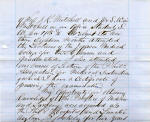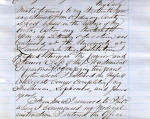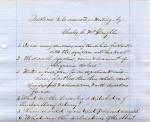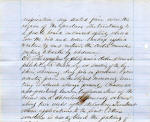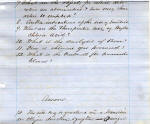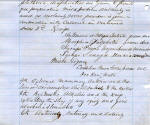Civil War U. S. Navy Applicant: Dr. Charles C. McGlaughlin
Dr. McGlaughlin's documents courtesy of Dr. Terry Hambrecht (The BEST researcher of Civil War medicine)
Applications for the Navy were made by civilian physicians who, during the application process were required to provide a biography and responses to a variety of medical related questions in order for the Naval Board to determine qualifications for the position. Many of these applications are rich with highly detailed medical content offering an interesting perspective on the medical knowledge and practices of the period. After the early years of the Wear, a vetting process was carried on by the various state militia boards in both the Union and Confederacy with oral exams to determine varying levels of competency as well as by the Federal Army Medical Department. (See additional information on the Federal Navy Medical Department.)
Because of the loss of medical officers to the Confederacy and the rapid build-up of the Navy during 1861, the Federal Navy quickly recruited civilian physicians into service. During the course of the war, three ranks existed for naval medical officers; assistant surgeon, passed assistant surgeon, and surgeon. The prospective surgeons made application in writing to the Navy and then were vetted by a board or individual as to their ability to serve and their medical experience. An example of one of those application is shown below.
Dr. Charles C. McGlaughlin served in the Civil War as both an Asst. Surgeon and a Surgeon with the 95th Pennsylvania Infantry from Dec. 1864. But it is not known at this point if he did in fact serve in the Navy. He is listed in the Army Roster of Regimental Surgeons for the 95th Infantry.
AMA Data: Name: Charles C. McGlaughlin
Death date: Dec 31, 1929
Death date note: This is an approximation of the individual's death date.
Type of practice: Allopath
States and years of licenses: PA, 1882
Medical school: Jefferson Medical College of Thomas Jefferson University, Philadelphia, 1856, (G)
Application to Navy Medical Department during the Civil War
Click on images to enlarge
(See examples of the written exam questions and answers for Union Navy applicant, Dr. George Snow including his biography.)
_____________________
From the Medical and Surgical History data:
CASE.--Lieutenant Charles Kennedy, Co. I, 28th Pennsylvania Volunteers, aged 25 years, was wounded at the battle of Chancellorsville, Virginia, May 2d, 1863, by a fragment of shell, which produced a wound two inches long and one inch wide, removing the superior portion of the occipital bone one inch to the right of the median line, destroying the membranes so that the substance of the brain protruded about one and a half inches. On May 7th, he was admitted to Armory Square Hospital, Washington. The wound had a burnt and black appearance, and the pulsation of the brain was very distinct with every beat of the heart. The patient's intellect was greatly impaired, and there was total loss of vision, so that he could nut distinguish day from night. The pulse was at 60 and full, and there was partial loss of power in the lower extremities. After admission to hospital, the hair was closely shaven around the wound, and the dead tissue was removed by sponging with tepid water. His bowels were constipated for seven days from the date of the injury, and he had scarcely any sleep. Cathartics, injections, and anodynes were administered. On May 11th, twelve leeches were applied to each temple, and three behind each ear. On the following day the symptoms were greatly ameliorated. On May 13th, spiculae of bone were removed, and also on the 15th, when the fungus had receded somewhat, and a healthy granulation was progressing. His appetite was good, no fever, vision partially restored, and able to get out of bed. He continued to improve, and on June 16th the fungus had entirely retracted, and vision was restored. The intellect was perfect and the general health good. On June 20th, Lieutenant Kennedy went home on leave of absence. He was subsequently admitted to the Officers' Hospital at Philadelphia. On September 9th, 1863, the wound had entirely healed. On November 12th, he was ordered before an examining board at Annapolis, and was returned to duty January 12th, 1864. On May 5th, 1864, he was admitted to the field hospital at Lookout Mountain, being again returned to duty about July, 1864. He was discharged the service July 20th, 1864, and afterward pensioned. Pension Examiner Wilson Jewell, under date of April 19th, 1865, reported that the patient suffers from cephalgia, vertigo, and weakness, when exposed to the sun or much excited. His disability was rated one-third and temporary. It was subsequently stated by Dr. C. C. McGlaughlin, late surgeon 95th Pennsylvania Volunteers, that he attended Lieutenant Kennedy in his last illness, and that he died December 15th, 1865, from the effects of a wound in his head. The plate opposite illustrates the appearance of the wound in May and June, 1863.
McGlaughlin was cited two other times in the M&SH.

